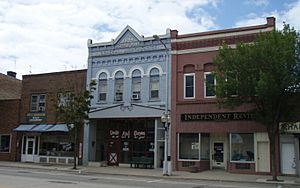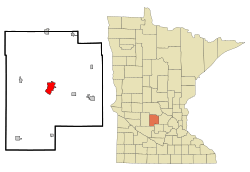Litchfield, Minnesota facts for kids
Quick facts for kids
Litchfield, Minnesota
|
|
|---|---|

The Litchfield Commercial Historic District
|
|

Location in Meeker County and the state of Minnesota
|
|
| Country | United States |
| State | Minnesota |
| County | Meeker |
| Platted | 1869 |
| Incorporated | February 29, 1872 |
| Area | |
| • Total | 5.45 sq mi (14.12 km2) |
| • Land | 4.48 sq mi (11.59 km2) |
| • Water | 0.98 sq mi (2.53 km2) |
| Elevation | 1,132 ft (345 m) |
| Population
(2020)
|
|
| • Total | 6,624 |
| • Estimate
(2022)
|
6,602 |
| • Density | 1,479.89/sq mi (571.44/km2) |
| Time zone | UTC−6 (Central (CST)) |
| • Summer (DST) | UTC−5 (CDT) |
| ZIP code |
55355
|
| Area code(s) | 320 |
| FIPS code | 27-37448 |
| GNIS feature ID | 2395732 |
| Sales tax | 7.375% |
Litchfield is a city in Meeker County, Minnesota, United States. It is the main city, also known as the county seat, of Meeker County. In 2020, about 6,624 people lived there.
Contents
History of Litchfield
People started moving to Meeker County more quickly after the St. Paul, Minneapolis and Manitoba Railroad arrived in 1869. The very first train came on August 13, 1869. The town was planned out in 1869. Farming and businesses related to farming were a big part of the local economy.
The first post office in Litchfield opened in a home on September 20, 1869. Later, it moved to a clothing store owned by the town's first official postmaster.
How Litchfield Got Its Name
The first settlers called their community "Ness" on April 5, 1858. They named it after a place in Norway called Næs, where many of them came from.
Litchfield got its current name from a man named Electus Bachus Darwin Litchfield. He was a businessman and investor in the St. Paul and Pacific Railroad. His investments helped build a train line through Meeker County.
Before being called Litchfield, the village had a few different names, like "Round Lake" and "Ripley."
Electus Litchfield helped the town by giving $2,000 to different religious groups to build churches. The Presbyterian Church, built in 1870, was the first church in Litchfield.
Most of the 350 people living there voted to name the town Litchfield instead of Ness. So, Litchfield officially became a village on February 29, 1872. The first village meeting was held on April 5, 1872.
Early Days as a Village
By 1871, Litchfield had grown much bigger than a nearby town called Forest City. The railroad built a special "immigrant's reception house." This building was for new immigrants. It had stoves for cooking, places to wash, and beds. Newcomers could stay there and buy food and clothes cheaply while they looked for land.
Most of the sidewalks in Litchfield were made of wood. But in 1895, the first cement sidewalk was built on Sibley Avenue.
Becoming a City
The village of Litchfield officially became a city in 1943.
Geography of Litchfield
Litchfield is located in the middle of Meeker County. Important roads like U.S. Highway 12, Minnesota State Highway 22, and Minnesota State Highway 24 pass through the city.
- US 12 goes east about 17 miles to Cokato.
- US 12 goes west about 30 miles to Willmar.
- MN 22 goes north about 24 miles to Richmond.
- MN 22 goes south-southeast about 21 miles to Hutchinson.
- MN 24 goes north about 22 miles to Kimball.
- Minneapolis is about 66 miles to the east, using US 12.
The U.S. Census Bureau says that Litchfield covers about 5.45 square miles. Most of this area, about 4.48 square miles, is land. The rest, about 0.98 square miles, is water. The city includes all of Lake Ripley, which is a natural lake. Jewitts Creek flows through the city to the north. It eventually leads to the North Fork of the Crow River.
Climate
| Climate data for Litchfield, Minnesota, 1991–2020 normals, extremes 1907–present | |||||||||||||
|---|---|---|---|---|---|---|---|---|---|---|---|---|---|
| Month | Jan | Feb | Mar | Apr | May | Jun | Jul | Aug | Sep | Oct | Nov | Dec | Year |
| Record high °F (°C) | 60 (16) |
60 (16) |
81 (27) |
93 (34) |
97 (36) |
101 (38) |
104 (40) |
104 (40) |
98 (37) |
90 (32) |
87 (31) |
62 (17) |
104 (40) |
| Mean maximum °F (°C) | 40.5 (4.7) |
43.8 (6.6) |
60.8 (16.0) |
77.6 (25.3) |
87.4 (30.8) |
91.0 (32.8) |
91.1 (32.8) |
89.7 (32.1) |
86.7 (30.4) |
80.4 (26.9) |
60.6 (15.9) |
44.1 (6.7) |
94.0 (34.4) |
| Mean daily maximum °F (°C) | 20.1 (−6.6) |
24.8 (−4.0) |
37.4 (3.0) |
53.3 (11.8) |
66.5 (19.2) |
76.8 (24.9) |
81.2 (27.3) |
78.7 (25.9) |
71.1 (21.7) |
56.4 (13.6) |
39.7 (4.3) |
25.5 (−3.6) |
52.6 (11.5) |
| Daily mean °F (°C) | 10.0 (−12.2) |
14.2 (−9.9) |
27.2 (−2.7) |
42.5 (5.8) |
55.6 (13.1) |
66.4 (19.1) |
70.7 (21.5) |
68.2 (20.1) |
59.7 (15.4) |
45.3 (7.4) |
30.3 (−0.9) |
16.5 (−8.6) |
42.2 (5.7) |
| Mean daily minimum °F (°C) | −0.2 (−17.9) |
3.6 (−15.8) |
16.9 (−8.4) |
31.6 (−0.2) |
44.8 (7.1) |
56.0 (13.3) |
60.2 (15.7) |
57.7 (14.3) |
48.3 (9.1) |
34.2 (1.2) |
20.9 (−6.2) |
7.4 (−13.7) |
31.8 (−0.1) |
| Mean minimum °F (°C) | −19.1 (−28.4) |
−15.0 (−26.1) |
−4.3 (−20.2) |
18.5 (−7.5) |
32.3 (0.2) |
44.0 (6.7) |
50.9 (10.5) |
48.1 (8.9) |
34.0 (1.1) |
21.1 (−6.1) |
5.4 (−14.8) |
−12.2 (−24.6) |
−22.0 (−30.0) |
| Record low °F (°C) | −37 (−38) |
−37 (−38) |
−32 (−36) |
−1 (−18) |
19 (−7) |
26 (−3) |
41 (5) |
37 (3) |
23 (−5) |
11 (−12) |
−17 (−27) |
−34 (−37) |
−37 (−38) |
| Average precipitation inches (mm) | 0.78 (20) |
0.78 (20) |
1.48 (38) |
2.65 (67) |
3.72 (94) |
4.58 (116) |
3.81 (97) |
4.08 (104) |
3.04 (77) |
2.56 (65) |
1.35 (34) |
0.95 (24) |
29.78 (756) |
| Average snowfall inches (cm) | 9.3 (24) |
6.7 (17) |
7.7 (20) |
3.4 (8.6) |
0.0 (0.0) |
0.0 (0.0) |
0.0 (0.0) |
0.0 (0.0) |
0.0 (0.0) |
0.3 (0.76) |
6.8 (17) |
6.5 (17) |
40.7 (104.36) |
| Average precipitation days (≥ 0.01 in) | 4.8 | 3.4 | 4.4 | 6.9 | 7.9 | 8.5 | 8.4 | 7.3 | 7.5 | 5.7 | 4.2 | 4.0 | 73.0 |
| Average snowy days (≥ 0.1 in) | 4.9 | 3.1 | 2.4 | 1.0 | 0.1 | 0.0 | 0.0 | 0.0 | 0.0 | 0.2 | 2.4 | 4.0 | 18.1 |
| Source 1: NOAA | |||||||||||||
| Source 2: National Weather Service | |||||||||||||
Population and People
| Historical population | |||
|---|---|---|---|
| Census | Pop. | %± | |
| 1870 | 353 | — | |
| 1880 | 1,250 | 254.1% | |
| 1890 | 1,899 | 51.9% | |
| 1900 | 2,280 | 20.1% | |
| 1910 | 2,333 | 2.3% | |
| 1920 | 2,790 | 19.6% | |
| 1930 | 2,880 | 3.2% | |
| 1940 | 3,920 | 36.1% | |
| 1950 | 4,608 | 17.6% | |
| 1960 | 5,078 | 10.2% | |
| 1970 | 5,262 | 3.6% | |
| 1980 | 5,904 | 12.2% | |
| 1990 | 6,041 | 2.3% | |
| 2000 | 6,562 | 8.6% | |
| 2010 | 6,574 | 0.2% | |
| 2020 | 6,624 | 0.8% | |
| 2022 (est.) | 6,602 | 0.4% | |
| U.S. Decennial Census 2020 Census |
|||
The census is like a big count of all the people living in a place. In 2010, there were 6,726 people living in Litchfield. There were 2,747 homes, and 1,749 families.
The city had about 1518.3 people per square mile. Most people (95.8%) were White. About 7.2% of the population was Hispanic or Latino.
In 2010, about 30.8% of homes had children under 18. About 48.4% of homes were married couples. The average age of people in Litchfield was 39.6 years old. About 24.9% of residents were under 18.
Famous People from Litchfield
Here are some notable people who have connections to Litchfield:
- Bernie Bierman (1894–1977), a famous football coach for the Minnesota Gophers.
- Florence Riddick Boys (1873–1963), a journalist and supporter of women's right to vote, born in Litchfield.
- John Carlson, Jr. (1984– ), a football player.
- Herbert W. Chilstrom (1931–2020), a leader of the Evangelical Lutheran Church in America.
- John W. Foss (1931–2020), a four-star general in the U.S. Army.
- Ann D. Montgomery (1949– ), a federal judge.
- William A. Nolen (1928–1986), a surgeon and author.
- Gale Sondergaard (1899–1985), an actress who won an Academy Award.
- Dan Sperry, a magician.
Historic Places to Visit
Litchfield has several interesting historic sites:
- The Grand Army of the Republic Hall (G.A.R.) was started in 1885 by veterans of the Civil War. They called themselves the "Boys of '61." This hall is one of the very few left in the nation and the only real one remaining in Minnesota. It was added to the National Register of Historic Places in 1975. The National Register of Historic Places is a list of places in the United States that are important to history.
- The Litchfield Commercial Historic District is a business area that looks much like it did in the late 1800s and early 1900s. It has 36 buildings built mostly between 1882 and 1940.
- The Henry Ames House was built in 1888–89 by Henry Ames, an early settler. This house is the only original building left from the Litchfield Brickyard, which operated from 1883 to 1900. It was added to the National Register of Historic Places in 1984.
- The Litchfield Opera House was built in 1900. It was designed by architect William T. Towner. Many people came to watch traveling shows perform here. It was added to the National Register of Historic Places in 1984.
- The Little Red Schoolhouse District 59 was built in 1913. It's a classic red brick schoolhouse with a hip roof and eight white columns. It cost $3,500 to build.
- Manannah (Union) Century Church was built in 1897. When fewer people attended in 1985, the church closed. A longtime church member, Esther Hegg, bought the church and helped move it to the Meeker County Fairgrounds in Litchfield, where it stands today.
- Ness Church was started in 1861. It is one of Minnesota's oldest historical sites and the first organized church in Meeker County. The first five victims of the Dakota War are buried in its cemetery.
- Trinity Episcopal Church, founded in 1871, was added to the National Register of Historic Places in 1975. Its design is by Richard Upjohn, a famous architect known for his "Carpenter Gothic" style.
See also
 In Spanish: Litchfield (Minnesota) para niños
In Spanish: Litchfield (Minnesota) para niños

